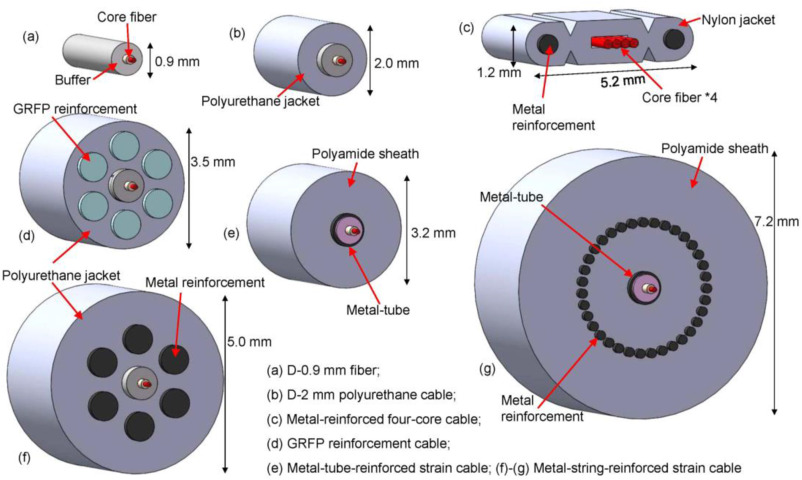【摘要】分布式光纤传感器(DFOS)具有测量长距离应变和温度变化的能力,显示出监测地下基础设施的卓越潜力。本研究对DFOS在监测和评估典型隧道基础设施变形行为方面的应用进行了最新的综述,包括盾构隧道、传统隧道以及沉管隧道和明挖回填隧道。同时考虑了基于布里渊散射和瑞利散射原理的DFOS系统。在实施DFOS监测时,光纤电缆可以主要沿横向和纵向安装,以(1)通过将光纤连续粘附到结构表面或嵌入衬砌来测量分布应变,或(2)通过将其点锚定在衬砌表面来测量点位移。DFOS监测有四个关键方面,包括传感光纤的正确选择、特定应用的测量原理的选择、有效传感器布局的设计以及稳健的现场传感器仪器的建立。对这四个问题进行了全面的讨论,并为DFOS在隧道基础设施监测中的实施提供了切实可行的建议。
【关键词】分布式光纤传感器(DFOS);隧道基础设施;分布式应变传感;点式位移监测;现场监测

【结论】分布式光纤传感(DFOS)系统能克服当前地下基础设施监测技术的一些局限性,特别是因为它们允许连续的分布式传感,而不是只进行局部测量。本研究全面概述了DFOS在隧道变形监测中的最新应用,覆盖了盾构隧道、新奥法隧道、沉管隧道和明挖回填隧道等多种类型。主要结论概述如下:
(1) DFOS已成功用于监测各种类型的隧道结构,实现了沿光纤的分布式应变传感和特定位置的点式位移测量。这些监测结果可用于识别隧道的横向变形和纵向弯曲,并获得接缝处的局部位移量。
(2) DFOS系统在隧道监测中的性能通常取决于四个方面:工作原理(解调系统)选择、传感光纤类型、传感器布局设计以及现场传感设备的稳定性。基于OFDR的DFOS通常具有高空间分辨率,但传感距离显著减小,这使其成为中小型实验中精确应变传感或局部隧道段现场监测的理想选择。相比之下,基于布里渊散射的DFOS具有较低的空间分辨率,但允许超长的传感距离,使其最适合长隧道基础设施的现场监测。
(3) 有效的传感器布局应考虑预期的应变监测范围,并明确光纤应变到可观察到的目标(如位移、弯曲变形等)之间的传递关系,同时要进行温度效应的校正,并评估光纤现场安装的便利性和隧道运行期间的保护措施。
(4) 对于新建隧道,可以将光纤嵌入隧道衬砌中。在新奥法隧道中,可以在现场浇筑混凝土之前将光纤固定在钢筋上,而对于盾构和沉管隧道,必须在管片中预制特殊通道,以便稍后安装光纤,或者在管片生产过程中将光纤嵌入各个管片中,在这种情况下,各个光纤段必须稍后在现场拼接在一起。对于现有隧道,传感器布局通常仅限于沿内表面连续连接(用于分布式应变传感)或固定在离散点(用于伸长计)的光缆,以监测横向倾斜和垂直椭圆化变形模式。将光纤固定在离散点时,应注意避免光纤的急剧弯曲导致信号丢失,例如仅将光纤点粘在钢钩上。
(5) 当监测隧道的横向变形时,可以从应变分布数据中获得轴向变形和弯曲变形的组合模式,在这种情况下,优选在隧道衬砌内嵌入两条平行光缆的传感器布局。对于纵向变形,可以通过使用安装在接缝间隙上的光纤伸长计监测周向接缝变形来观察盾构隧道的弯曲变形。一般来说,隧道接缝处的局部变形可以通过放置在接缝间隙上的单个或组合光纤伸长计进行有效测量,并且这种布局已被证明在盾构隧道和水下隧道中都能成功工作。最后,在新奥法隧道中,隧道拱顶附近的地层沉降可以通过纵向嵌入衬砌或安装在衬砌表面离散点的光缆进行有效监测。
总之,DFOS已在许多隧道监测项目中已经成功实施,包括盾构隧道、沉管隧道和传统隧道。它已经证明了巨大的潜力,因为它允许在比传统技术更高密度的具有成本效益的监测点进行分布式应变和位移监测。
Distributed fiber optic sensors for tunnel monitoring: A state-of-the-art review
Xuehui Zhang a, Honghu Zhu b, Xi Jiang c, Wout Broere a
a Geo-Engineering Section, Department of Geoscience and Engineering, Delft University of Technology, Delft, 2628CN, the Netherlands
b School of Earth Sciences and Engineering, Nanjing University, Nanjing, 210023, China
c Department of Civil and Environmental Engineering, The Hong Kong Polytechnic University, Kowloon, Hong Kong, China
https://doi.org/10.1016/j.jrmge.2024.01.008
【Abstract】Distributed fiber optic sensors (DFOSs) possess the capability to measure strain and temperature variations over long distances, demonstrating outstanding potential for monitoring underground infrastructure. This study presents a state-of-the-art review of the DFOS applications for monitoring and assessing the deformation behavior of typical tunnel infrastructure, including bored tunnels, conventional tunnels, as well as immersed and cut-and-cover tunnels. DFOS systems based on Brillouin and Rayleigh scattering principles are both considered. When implementing DFOS monitoring, the fiber optic cable can be primarily installed along transverse and longitudinal directions to (1) measure distributed strains by continuously adhering the fiber to the structure’s surface or embedding it in the lining, or (2) measure point displacements by spot-anchoring it on the lining surface. There are four critical aspects of DFOS monitoring, including proper selection of the sensing fiber, selection of the measuring principle for the specific application, design of an effective sensor layout, and establishment of robust field sensor instrumentation. These four issues are comprehensively discussed, and practical suggestions are provided for the implementation of DFOS in tunnel infrastructure monitoring.
【Keywords】Distributed fiber optic sensor (DFOS); Tunnel infrastructure; Distributed strain sensing; Point displacement monitoring; Field instrumentation
【Conclusions】
Distributed fiber optic sensor (DFOS) systems can overcome some of the limitations of the current monitoring techniques for underground infrastructure, especially as they allow for continuous distributed sensing instead of taking only localized measurements. This study presents a comprehensive overview of the emerging use of DFOS for deformation monitoring of tunnel structures, looking at applications for bored tunnels, NATM tunnels, as well as immersed and cut-cover tunnels. The main conclusions are summarized as.
(1) DFOS has been successfully utilized to instrument various types of tunnel structures, enabling both distributed strain measurements along the fiber and point displacement measurements at specific locations. These monitoring results can be used to determine the tunnel’s transverse deformation behavior as well as longitudinal flexural behavior and establish the amount of localized displacement at the joints.
(2) The performance of a DFOS system in tunnel monitoring typically depends on four aspects: the selection of the working principle (interrogator system), the selection of the optimal sensing fiber, the design of an effective sensor layout, and the establishment of robust field sensor instrumentation. DFOS based on OFDR typically has a high spatial resolution, but a significantly reduced sensing distance, making it ideal for precise distributed strain sensing in small to medium-scale experiments, or field monitoring of local tunnel sections. In contrast, DFOS based on Brillouin scattering has a lower spatial resolution, but allows for a significantly greater sensing distance, making it optimal for field applications in long tunnel infrastructure.
(3) An effective sensor layout should consider the expected range of observed strain in the fiber, establish an explicit transfer relation from fiber strain to the target observable (displacement, flexural deflection, etc.) that corrects for temperature influences, and takes the ease of field installation as well as the protection of the fiber during tunnel operation into account.
(4) For newly built tunnels the fiber can be embedded into the tunnel lining. In NATM tunnels this can be achieved by securing the fiber to the rebar prior to concreting on site, whereas for bored and immersed tunnels either special ducts have to be prepared in the segments, allowing for later fiber installation, or the fiber has to be embedded in individual segments during segment production, and in that case, the individual fiber sections have to be spliced together on site later. For existing tunnels, the sensor layout is typically limited to a cable continuously bonded (for distributed strain sensing) or fixed at discrete points (for extensometer use) along the inner surface to monitor the transverse oblique and vertical ovalization deformation modes. When fixing the fiber at discrete points, care should be taken to avoid sharp bends in the fiber leading to signal loss, caused for example by spot gluing the fiber onto steel hooks only.
(5) When monitoring the tunnel’s transverse behavior, the combined axial-flexural deformation mode can be obtained from the distributed strain, in which case a fiber layout with two parallel fiber optic cables embedded inside the tunnel lining is preferable. For the longitudinal behavior, the flexural deformation of bored tunnels can be observed by monitoring the circumferential joint deformations using fiber optic extensometers installed across the joint gaps. In general, local deformations at tunnel joints can be effectively measured by single or combined fiber optic extensometers placed across the joint gap, and such layouts have been demonstrated to work successfully in both bored and immersed tunnels. Finally, in NATM tunnels the settlement of surrounding soil near the tunnel crown can be effectively monitored by fiber optic cables embedded longitudinally into the lining or mounted at discrete spots on the lining surface.
In summary, DFOS has been successfully implemented in a number of tunnel monitoring projects, for both bored, immersed, and conventional tunnels. It has demonstrated great potential as it allows for both distributed strain and displacement monitoring at higher densities of cost-effective monitoring points than conventional techniques.
